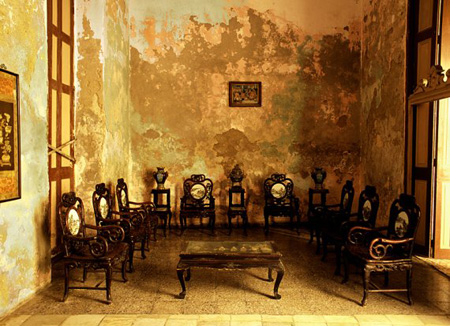
Continuing through September 17, 2011
After the 1989 fall of the USSR, Cuba, once reckoned a dagger pointed at Florida beach hotels, gradually took on a curious role. It’s the last vestige of Marxist-Leninist thought within firing range of the United States, and still anathema to Cold Warriors. But it’s also, thanks to U.S. economic sanctions, a time capsule of the late 1950s, and thus an object of nostalgia as well as a liberal’s social utopia (at least if you saw “Sicko” or “Buena Vista Social Club”). Charles Anselmo, enamored of Cuba and its people, has made many trips to Havana since 1990, photographing its urban landscape, infused by time with history and human presence. “Deconstructions: La Habana” presents stunning color photographs of that open-air colonial-era stage set, printed photographic banners on silk, and small black-and-white studies of workers’ hands.
In postmodern theory, deconstruction is an analysis of societal power structures hidden within cultural artifacts (e.g., buildings and photographs). In that context artworks are analyzed from political and economic perspectives rather than aesthetically, and “grand narratives” like the triumphs of various ideologies are deflated. Anselmo considers Havana to be “achingly beautiful and conflicted,” and describes his perambulations there as “like walking inside a living thing,” so his achingly beautiful arrangements of texture, pattern and color transcend political ideology. Like Walker Evans’ photos of Depression-era sharecroppers’ shacks or antebellum mansions gone to seed, Anselmo’s paradoxically opulent photos of crumbling, lichen-covered walls; gaping, corroded, electrical junction boxes; stained wallpapers; patches of fallen plaster and stucco; and refuse-filled gated doorways (“Bernaza y Brasil,” “Havana Gate,” “Missing Building,” “Malecon Electrics #26”) are both documentary and suffused with emotion.
